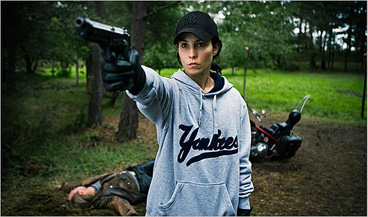Chapter Two: The Girl Who Played With Fire
By Brett Beach
February 3, 2011
And all of this is nice, but it’s still condensed and compacted and somewhat off-topic, and leaves me close to a million miles away from this week’s subject. Without further adieu...
The Girl Who Played with Fire is the screen adaptation of the second book in Larsson’s series about the unlikely friendship between Mikael Blomkvist, a crusading journalist with a knack for pissing off important people in very high places, and Lisbeth Salander, an anti-social hacker whose overt guardedness comes from a lifetime of physical and emotional abuse. I have not read any of the books yet, but, as crammed full of plot as all three movies are, it seems likely to me that they are faithful adaptations. Two of the movies run just under or over two-and-a-half-hours and the other clocks in at over the two-hour mark.
There is a horrific rape in Dragon Tattoo that is taped and replayed by various parties and for various purposes in the second and third films. There are serial killers, murderous gangsters, corrupt government officials, sadistic psychiatrists, covert shadow organizations, brutal fistfights, attempted murders (not always successful) via gun, chainsaw, rope, axe, and fire, and dark family secrets involving incest, murderous appetites, and heretofore unknown siblings. Thankfully, all of the movies replay key information enough times so that becoming lost in a thicket of exposition is harder than it would seem.
While the three novels and films do indeed form a trilogy, only The Girl Who Played with Fire ends with an actual cliffhanger. The Girl with the Dragon Tattoo is mostly a self-contained story populated with characters that will not be a part of the other stories. It is this tale that serves to bring Blomkvist and Salander together for the first time and establishes the emotional connection that is maintained between them in the second and third films, even when their total screen time together in those installments easily clocks in at under thirty minutes. They communicate by computer, text, phone, and other characters, but very rarely face to face. They do sleep together several times, but even then, their connection is hardly about sex or physical attraction. In fact, the films do a good job of maintaining the semblance of a “father/daughter” relationship among the pair — he has no children and no significant long-term romantic involvements and she, for all intents and purposes, has been without parents since the age of 12.
As ridiculous as the plots get with their level of coincidences, and the way in which it seems everybody in Sweden has only one degree of separation from everybody else, Larsson’s plotting finds an ingenious way to undercut the potential for ridicule. From the manner in which Blomkvist and Salander are first brought together (the security company she works for is investigating him on behalf of an industrialist who would like to hire him to look into his family’s sordid past) to the recurring themes of secrets — family, political, national, and otherwise — that refuse to stay buried, Larsson constructs his fictional world like a house of cards where everything is inherently connected. When two disparate loners are brought together (say, a journalist and a computer whiz), it is only a matter of time before their encounter has unforeseeable ramifications.
Continued:
1
2
3
4
5




